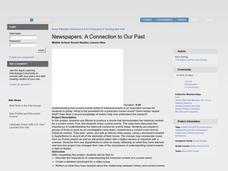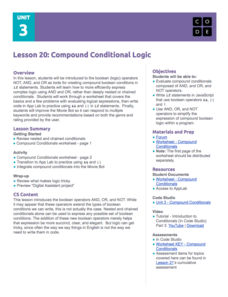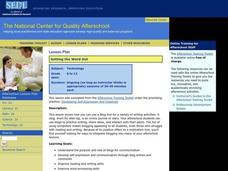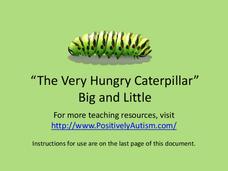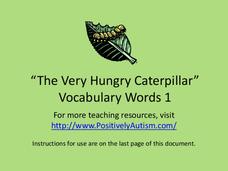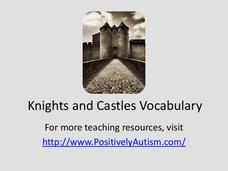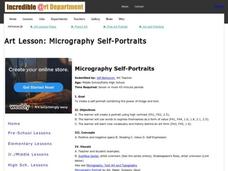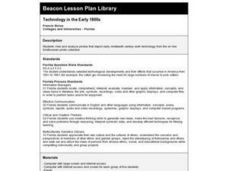Curated OER
How Animals Meet Their Needs
Fourth graders research the Internet for facts relating to the animal of their choice. They use information from their Internet search to complete their animal project. TLW use his or her own words when writing their report.
Curated OER
Working on the Railroad
Learners view and discuss "The Transportation Revolution," a lecture by Peter A. Coclanis. They read and respond creatively to brief descriptions of railroad workers and their job responsibilities.
Curated OER
How do We Treat Our Environment?
Seventh graders explore the concept of collecting data. In this data collection lesson, 7th graders survey others about their environmental habits. Students graph their data.
Teach Engineering
Exploring Bone Mineral Density
Bone up on bone density. The second installment of the seven-part series has pupils read articles on two different websites to learn about bone density and its measurement, as well as X-rays and other imaging tools. A quiz assesses their...
Computer Science Unplugged
Tablets of Stone—Network Communication Protocols
Show your learners that the game of Telephone isn't the only way messages get mixed up. Pairs transform into the sender and receiver of a message sent in packets. At least one pupil is the messenger who either delivers, delays, or...
Computer Science Unplugged
Card Flip Magic—Error Detection and Correction
I can find the error in an array of cards? After watching a demonstration class members search for the error is the provided cards. The resource provides a real-life example of using ISBN numbers in error detection and using check...
Code.org
Processing Arrays
Scholars use a playing card activity to help them develop a program to find the minimum value of a list. They learn to use for loops to write code that will process lists.
Curated OER
Newspapers: A Connection to Our Past
Students discuss current events and importance of understanding historical context for events today. They research current event and its historical context, and plan, shoot, and edit iMovie video essay using AppleWorks storyboard.
Teach Engineering
Exploring Acceleration with an Android
Small groups use rubber bands to accelerate an Android device along a track of books. They collect the acceleration data and analyze it in order to determine the device's velocity.
Code.org
Compound Conditional Logic
Scholars explore compound conditional logic and learn to use the Boolean operators AND, OR, and NOT within conditional statements by incorporating these operators to improve a previously created app.
Curated OER
The Pythagorean Theorem Lesson 2
Learners discuss and review examples of the Pythagorean Theorem using a GSP, Geometer's Sketchpad, activity.
Curated OER
Getting the Word Out
Discuss and generate blogs in this technology lesson. Middle and high schoolers explore examples of blogs and create their own blogs. Use this lesson throughout the year to reinforce concepts from your language arts class (or any class)....
PHET
Planet Designer: What’s Trending Hot?
Excite scholars to design their own planet in this first of five lessons. The lesson starts with a pre-activity assessment, a complete lesson plan that is easy to implement, and a post-activity assessment that would look great...
Math Stars
Math Stars: a Problem-Solving Newsletter Grade 8
You've just hit the jackpot of integrating math problems and riddles with this jumbo-sized resource! Written as a newsletter, scroll through 35 pages of puzzles and quality problems to engage and encourage your learners to inquire...
Positively Autism
The Very Hungry Caterpillar Big and Little Activity
A big caterpillar, a little caterpillar. A big butterfly, a little butterfly. Images from Eric Carle's The Very Hungry Caterpillar model for learners with autism the difference between big and little.
Positively Autism
The Very Hungry Caterpillar Vocabulary
Moon, eggs, leaf, sun, caterpillar. Prior to reading Eric Carle's classic tale, introduce vocabulary for The Very Hungry Caterpillar with these picture cards that also include the vocabulary word printed in large type.
Positively Autism
Knights and Castles Vocabulary
Are your learners fascinated by dragons, knights, ladies? Capture their their interest with words associated with knights and castles. Each page features one image and the vocabulary printed in large type.
BrainPOP
U.S. Symbols
United States symbols are the subject of a video brought to you by BrainPop Jr. Hosts, Annie and Moby, begin with a definition of the word symbol, then go on to detail ten American symbols—the American flag, a Bald Eagle, the Liberty...
PBS
Stories of Painkiller Addiction: The Cycle of Addiction
Drug addiction, including prescription drug addiction, begins with a reason that's different for every user. High schoolers learn more about the reasons people begin abusing drugs with a set of videos and worksheets that discuss four...
Incredible Art
Micrography Self-Portraits
Words. Words. Words. Class members create micrography self-portraits combining a high contrast portrait photo with words that express themselves. Complete directions for the project, student samples, along with links to professional...
University of Arkansas
Our Responsibilities
The fourth in a five-lesson unit examining human rights and personal responsibility asks class groups to investigate a current rights issue, and using the provided graphic organizer, summarize the issue, consider which rights are being...
Curated OER
Lesson Learned: Creating a Life Reports Project
Tap into the wisdom and knowledge of older members of the community with this New York Times plan. To warm up, learners write about and discuss advice they have been given. After reading "The Life Report," an op-ed column that asks older...
Texas Instruments
TI-Nspire™
We landed on the moon with less computing capabilities than you can find in this app! Here is a multiple function calculator that takes all the power you get from a handheld and adds the wonderful large screen that only a tablet can...
Curated OER
Technology in the Early 1800s
Fifth graders, in groups, select ten photos about work and technology in the early 1800's from the Smithsonian Internet site for analysis. They discuss the photos and write a short description of day in the life of a worker.







